University Report: Employee Performance and Selection Process Analysis
VerifiedAdded on 2021/04/24
|12
|2653
|337
Report
AI Summary
This report investigates the impact of recruitment and selection processes on employee performance within the hospitality sector. Employing a qualitative research methodology, the study utilizes interview methods and quota sampling to gather data from employees and managers. The research explores the methodology, including research methods, data collection techniques (primary and secondary), and analysis methods (open coding and axial coding). Ethical considerations and limitations of the research are also addressed, along with a discussion of the research instrument used. The report highlights the importance of a well-defined recruitment and selection process in enhancing employee performance, offering insights into the relationship between these processes and overall organizational success. The study also acknowledges limitations related to the qualitative approach, such as reliance on researcher skills and potential biases.
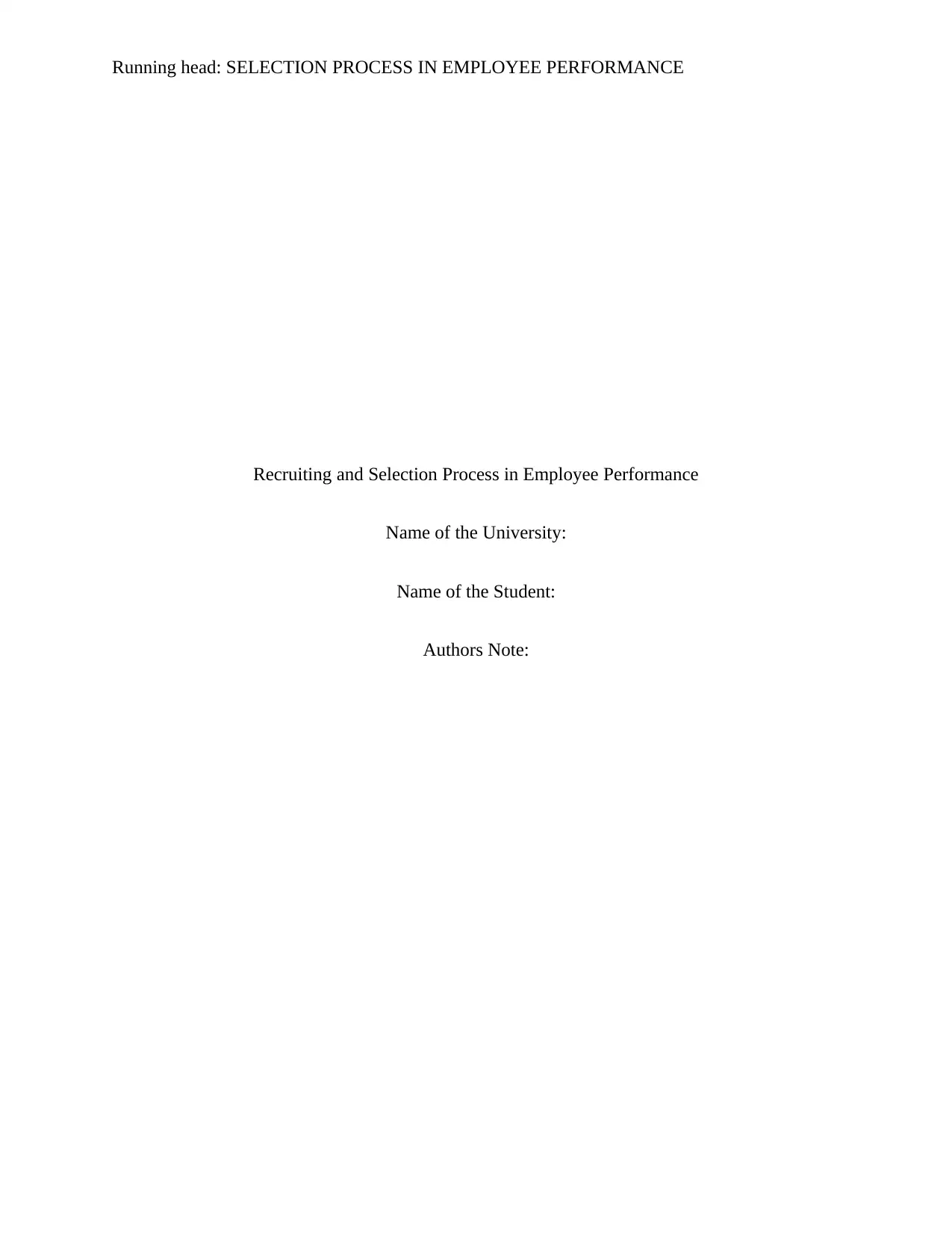
Running head: SELECTION PROCESS IN EMPLOYEE PERFORMANCE
Recruiting and Selection Process in Employee Performance
Name of the University:
Name of the Student:
Authors Note:
Recruiting and Selection Process in Employee Performance
Name of the University:
Name of the Student:
Authors Note:
Paraphrase This Document
Need a fresh take? Get an instant paraphrase of this document with our AI Paraphraser
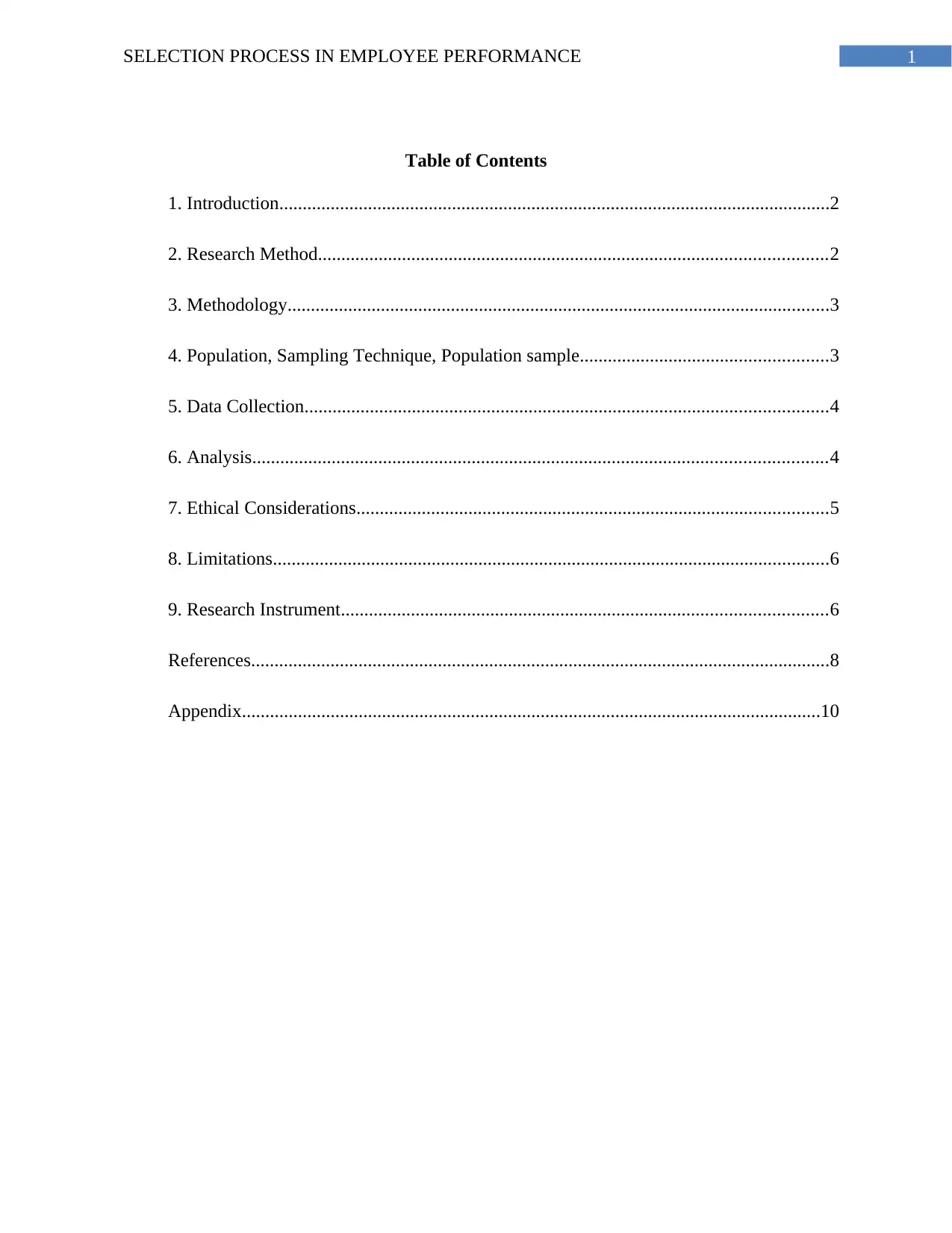
1SELECTION PROCESS IN EMPLOYEE PERFORMANCE
Table of Contents
1. Introduction......................................................................................................................2
2. Research Method.............................................................................................................2
3. Methodology....................................................................................................................3
4. Population, Sampling Technique, Population sample.....................................................3
5. Data Collection................................................................................................................4
6. Analysis...........................................................................................................................4
7. Ethical Considerations.....................................................................................................5
8. Limitations.......................................................................................................................6
9. Research Instrument........................................................................................................6
References............................................................................................................................8
Appendix............................................................................................................................10
Table of Contents
1. Introduction......................................................................................................................2
2. Research Method.............................................................................................................2
3. Methodology....................................................................................................................3
4. Population, Sampling Technique, Population sample.....................................................3
5. Data Collection................................................................................................................4
6. Analysis...........................................................................................................................4
7. Ethical Considerations.....................................................................................................5
8. Limitations.......................................................................................................................6
9. Research Instrument........................................................................................................6
References............................................................................................................................8
Appendix............................................................................................................................10
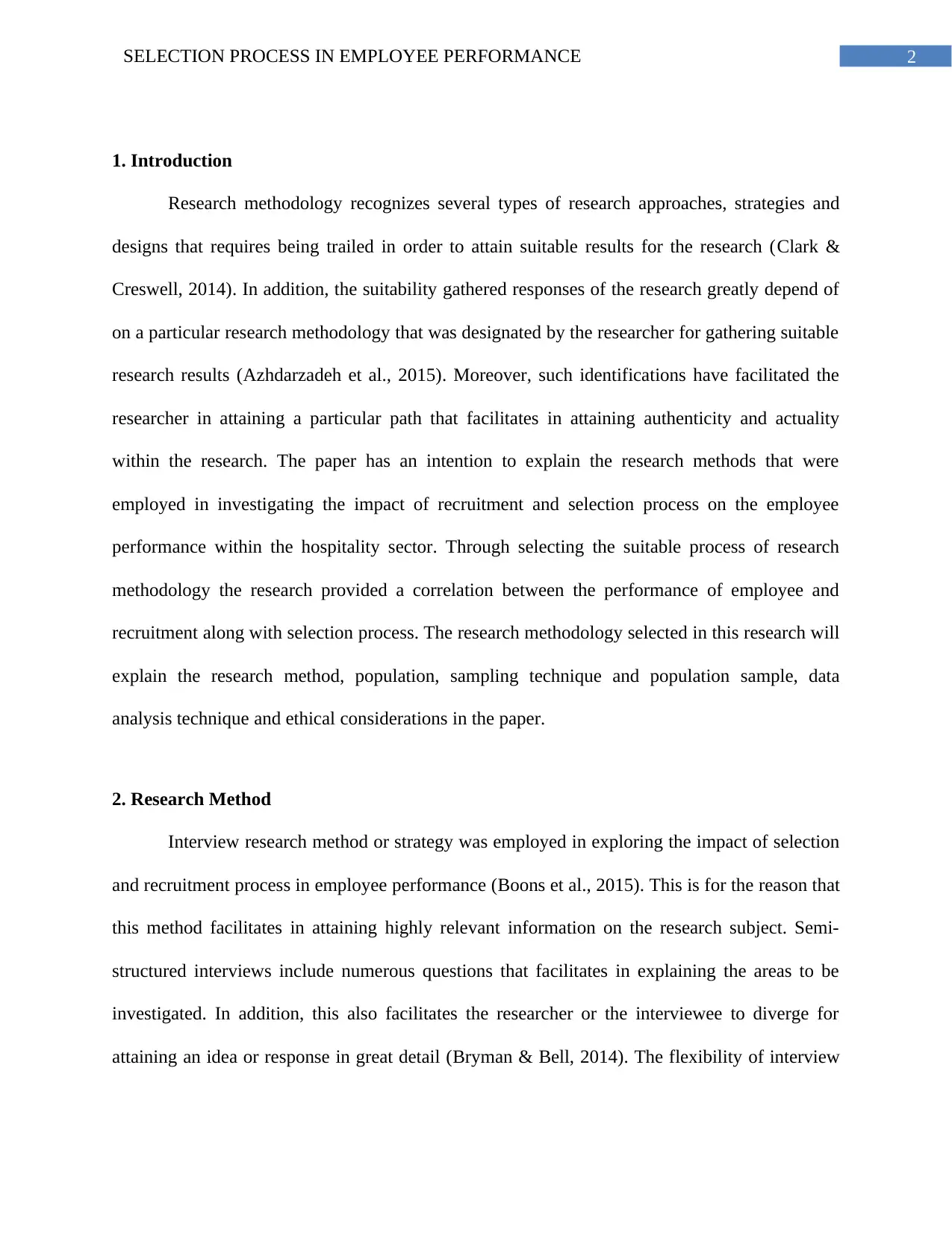
2SELECTION PROCESS IN EMPLOYEE PERFORMANCE
1. Introduction
Research methodology recognizes several types of research approaches, strategies and
designs that requires being trailed in order to attain suitable results for the research (Clark &
Creswell, 2014). In addition, the suitability gathered responses of the research greatly depend of
on a particular research methodology that was designated by the researcher for gathering suitable
research results (Azhdarzadeh et al., 2015). Moreover, such identifications have facilitated the
researcher in attaining a particular path that facilitates in attaining authenticity and actuality
within the research. The paper has an intention to explain the research methods that were
employed in investigating the impact of recruitment and selection process on the employee
performance within the hospitality sector. Through selecting the suitable process of research
methodology the research provided a correlation between the performance of employee and
recruitment along with selection process. The research methodology selected in this research will
explain the research method, population, sampling technique and population sample, data
analysis technique and ethical considerations in the paper.
2. Research Method
Interview research method or strategy was employed in exploring the impact of selection
and recruitment process in employee performance (Boons et al., 2015). This is for the reason that
this method facilitates in attaining highly relevant information on the research subject. Semi-
structured interviews include numerous questions that facilitates in explaining the areas to be
investigated. In addition, this also facilitates the researcher or the interviewee to diverge for
attaining an idea or response in great detail (Bryman & Bell, 2014). The flexibility of interview
1. Introduction
Research methodology recognizes several types of research approaches, strategies and
designs that requires being trailed in order to attain suitable results for the research (Clark &
Creswell, 2014). In addition, the suitability gathered responses of the research greatly depend of
on a particular research methodology that was designated by the researcher for gathering suitable
research results (Azhdarzadeh et al., 2015). Moreover, such identifications have facilitated the
researcher in attaining a particular path that facilitates in attaining authenticity and actuality
within the research. The paper has an intention to explain the research methods that were
employed in investigating the impact of recruitment and selection process on the employee
performance within the hospitality sector. Through selecting the suitable process of research
methodology the research provided a correlation between the performance of employee and
recruitment along with selection process. The research methodology selected in this research will
explain the research method, population, sampling technique and population sample, data
analysis technique and ethical considerations in the paper.
2. Research Method
Interview research method or strategy was employed in exploring the impact of selection
and recruitment process in employee performance (Boons et al., 2015). This is for the reason that
this method facilitates in attaining highly relevant information on the research subject. Semi-
structured interviews include numerous questions that facilitates in explaining the areas to be
investigated. In addition, this also facilitates the researcher or the interviewee to diverge for
attaining an idea or response in great detail (Bryman & Bell, 2014). The flexibility of interview
⊘ This is a preview!⊘
Do you want full access?
Subscribe today to unlock all pages.

Trusted by 1+ million students worldwide
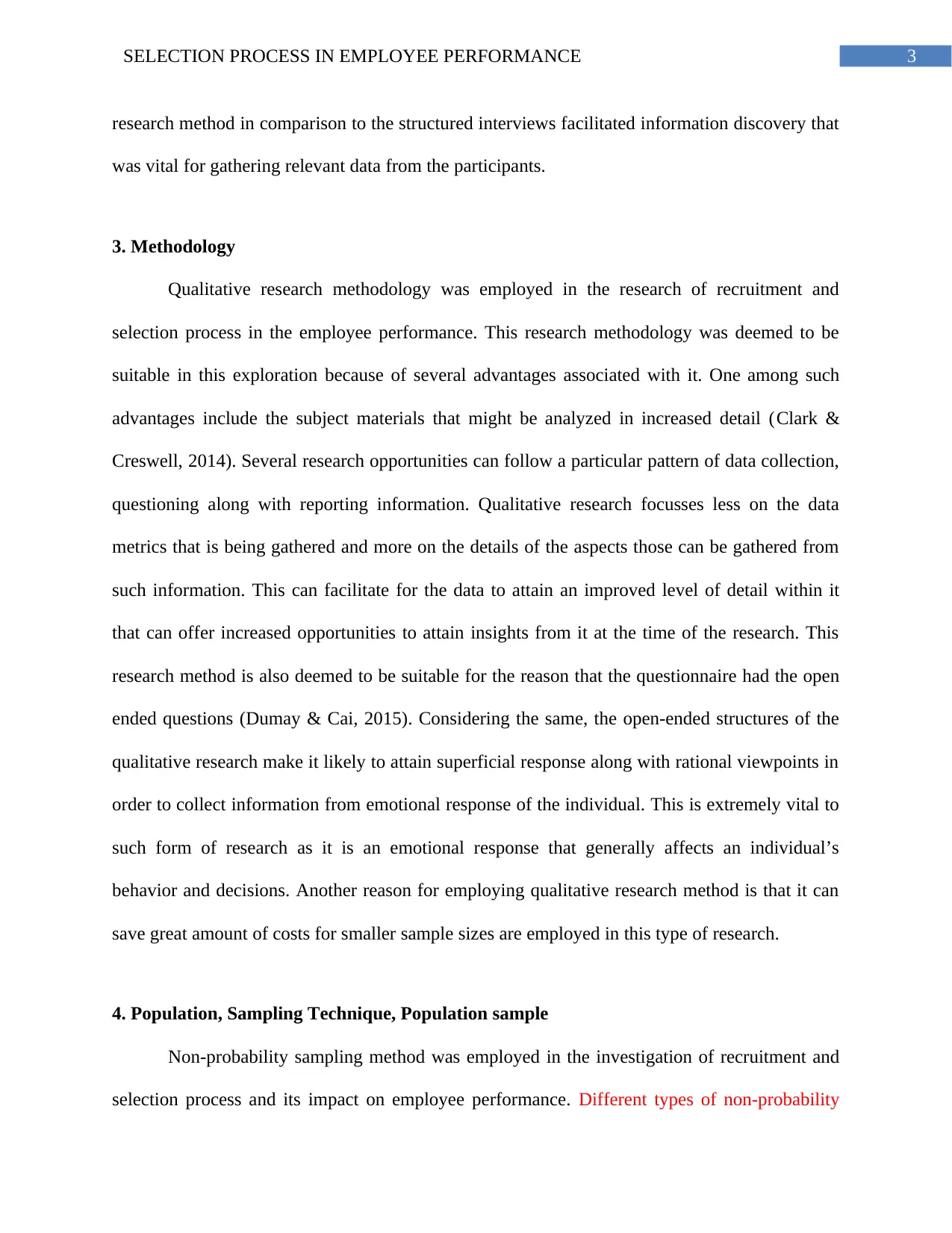
3SELECTION PROCESS IN EMPLOYEE PERFORMANCE
research method in comparison to the structured interviews facilitated information discovery that
was vital for gathering relevant data from the participants.
3. Methodology
Qualitative research methodology was employed in the research of recruitment and
selection process in the employee performance. This research methodology was deemed to be
suitable in this exploration because of several advantages associated with it. One among such
advantages include the subject materials that might be analyzed in increased detail (Clark &
Creswell, 2014). Several research opportunities can follow a particular pattern of data collection,
questioning along with reporting information. Qualitative research focusses less on the data
metrics that is being gathered and more on the details of the aspects those can be gathered from
such information. This can facilitate for the data to attain an improved level of detail within it
that can offer increased opportunities to attain insights from it at the time of the research. This
research method is also deemed to be suitable for the reason that the questionnaire had the open
ended questions (Dumay & Cai, 2015). Considering the same, the open-ended structures of the
qualitative research make it likely to attain superficial response along with rational viewpoints in
order to collect information from emotional response of the individual. This is extremely vital to
such form of research as it is an emotional response that generally affects an individual’s
behavior and decisions. Another reason for employing qualitative research method is that it can
save great amount of costs for smaller sample sizes are employed in this type of research.
4. Population, Sampling Technique, Population sample
Non-probability sampling method was employed in the investigation of recruitment and
selection process and its impact on employee performance. Different types of non-probability
research method in comparison to the structured interviews facilitated information discovery that
was vital for gathering relevant data from the participants.
3. Methodology
Qualitative research methodology was employed in the research of recruitment and
selection process in the employee performance. This research methodology was deemed to be
suitable in this exploration because of several advantages associated with it. One among such
advantages include the subject materials that might be analyzed in increased detail (Clark &
Creswell, 2014). Several research opportunities can follow a particular pattern of data collection,
questioning along with reporting information. Qualitative research focusses less on the data
metrics that is being gathered and more on the details of the aspects those can be gathered from
such information. This can facilitate for the data to attain an improved level of detail within it
that can offer increased opportunities to attain insights from it at the time of the research. This
research method is also deemed to be suitable for the reason that the questionnaire had the open
ended questions (Dumay & Cai, 2015). Considering the same, the open-ended structures of the
qualitative research make it likely to attain superficial response along with rational viewpoints in
order to collect information from emotional response of the individual. This is extremely vital to
such form of research as it is an emotional response that generally affects an individual’s
behavior and decisions. Another reason for employing qualitative research method is that it can
save great amount of costs for smaller sample sizes are employed in this type of research.
4. Population, Sampling Technique, Population sample
Non-probability sampling method was employed in the investigation of recruitment and
selection process and its impact on employee performance. Different types of non-probability
Paraphrase This Document
Need a fresh take? Get an instant paraphrase of this document with our AI Paraphraser
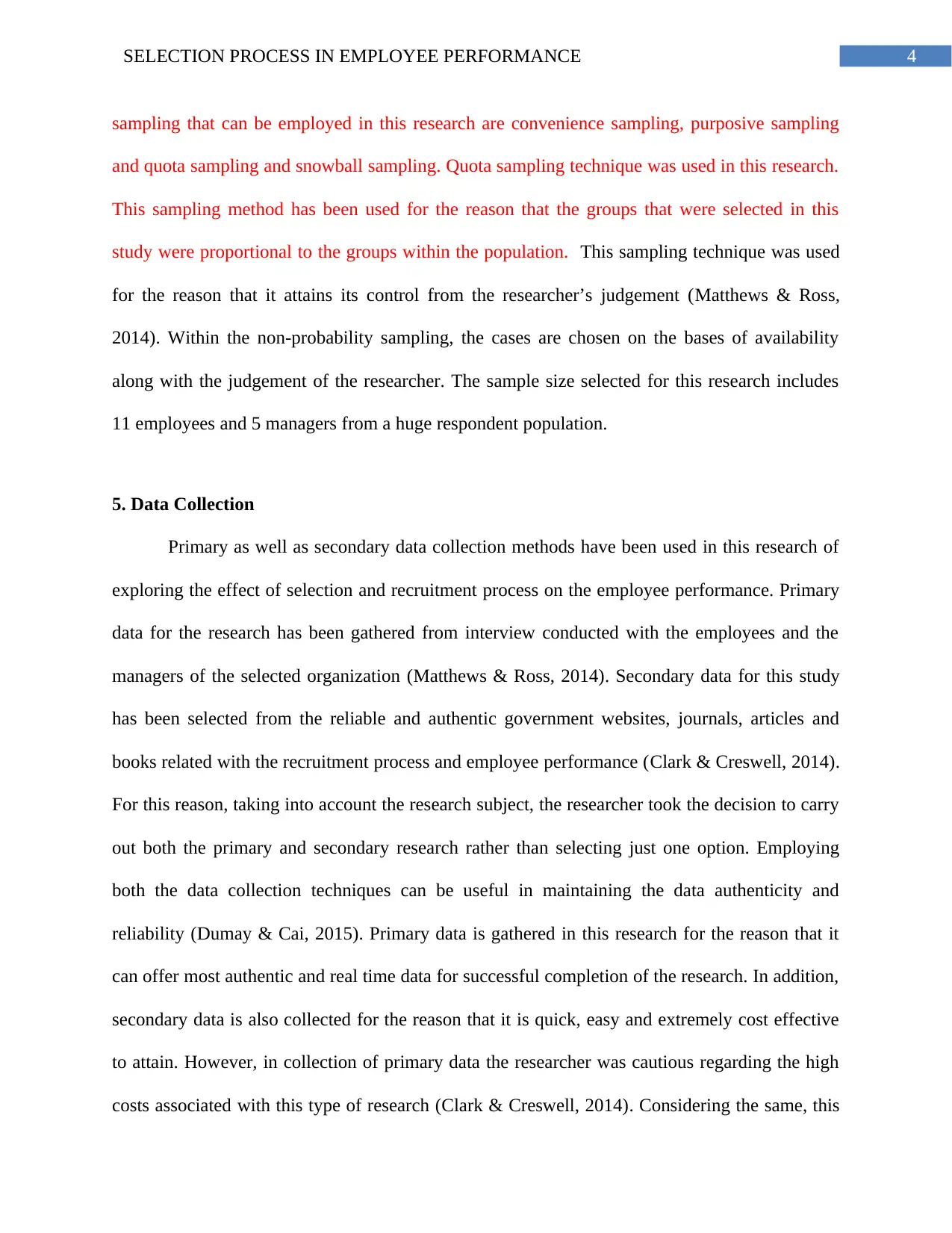
4SELECTION PROCESS IN EMPLOYEE PERFORMANCE
sampling that can be employed in this research are convenience sampling, purposive sampling
and quota sampling and snowball sampling. Quota sampling technique was used in this research.
This sampling method has been used for the reason that the groups that were selected in this
study were proportional to the groups within the population. This sampling technique was used
for the reason that it attains its control from the researcher’s judgement (Matthews & Ross,
2014). Within the non-probability sampling, the cases are chosen on the bases of availability
along with the judgement of the researcher. The sample size selected for this research includes
11 employees and 5 managers from a huge respondent population.
5. Data Collection
Primary as well as secondary data collection methods have been used in this research of
exploring the effect of selection and recruitment process on the employee performance. Primary
data for the research has been gathered from interview conducted with the employees and the
managers of the selected organization (Matthews & Ross, 2014). Secondary data for this study
has been selected from the reliable and authentic government websites, journals, articles and
books related with the recruitment process and employee performance (Clark & Creswell, 2014).
For this reason, taking into account the research subject, the researcher took the decision to carry
out both the primary and secondary research rather than selecting just one option. Employing
both the data collection techniques can be useful in maintaining the data authenticity and
reliability (Dumay & Cai, 2015). Primary data is gathered in this research for the reason that it
can offer most authentic and real time data for successful completion of the research. In addition,
secondary data is also collected for the reason that it is quick, easy and extremely cost effective
to attain. However, in collection of primary data the researcher was cautious regarding the high
costs associated with this type of research (Clark & Creswell, 2014). Considering the same, this
sampling that can be employed in this research are convenience sampling, purposive sampling
and quota sampling and snowball sampling. Quota sampling technique was used in this research.
This sampling method has been used for the reason that the groups that were selected in this
study were proportional to the groups within the population. This sampling technique was used
for the reason that it attains its control from the researcher’s judgement (Matthews & Ross,
2014). Within the non-probability sampling, the cases are chosen on the bases of availability
along with the judgement of the researcher. The sample size selected for this research includes
11 employees and 5 managers from a huge respondent population.
5. Data Collection
Primary as well as secondary data collection methods have been used in this research of
exploring the effect of selection and recruitment process on the employee performance. Primary
data for the research has been gathered from interview conducted with the employees and the
managers of the selected organization (Matthews & Ross, 2014). Secondary data for this study
has been selected from the reliable and authentic government websites, journals, articles and
books related with the recruitment process and employee performance (Clark & Creswell, 2014).
For this reason, taking into account the research subject, the researcher took the decision to carry
out both the primary and secondary research rather than selecting just one option. Employing
both the data collection techniques can be useful in maintaining the data authenticity and
reliability (Dumay & Cai, 2015). Primary data is gathered in this research for the reason that it
can offer most authentic and real time data for successful completion of the research. In addition,
secondary data is also collected for the reason that it is quick, easy and extremely cost effective
to attain. However, in collection of primary data the researcher was cautious regarding the high
costs associated with this type of research (Clark & Creswell, 2014). Considering the same, this
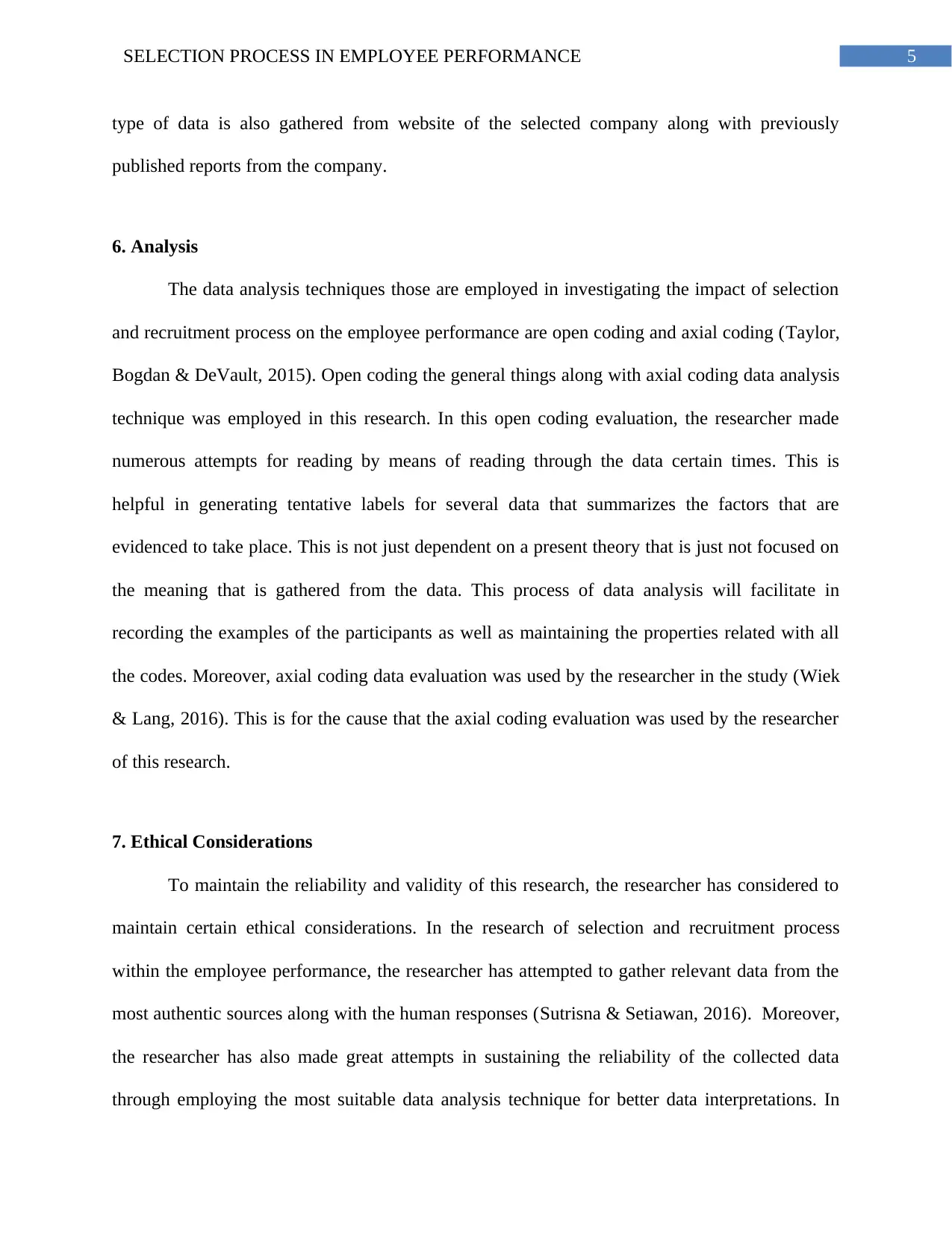
5SELECTION PROCESS IN EMPLOYEE PERFORMANCE
type of data is also gathered from website of the selected company along with previously
published reports from the company.
6. Analysis
The data analysis techniques those are employed in investigating the impact of selection
and recruitment process on the employee performance are open coding and axial coding (Taylor,
Bogdan & DeVault, 2015). Open coding the general things along with axial coding data analysis
technique was employed in this research. In this open coding evaluation, the researcher made
numerous attempts for reading by means of reading through the data certain times. This is
helpful in generating tentative labels for several data that summarizes the factors that are
evidenced to take place. This is not just dependent on a present theory that is just not focused on
the meaning that is gathered from the data. This process of data analysis will facilitate in
recording the examples of the participants as well as maintaining the properties related with all
the codes. Moreover, axial coding data evaluation was used by the researcher in the study (Wiek
& Lang, 2016). This is for the cause that the axial coding evaluation was used by the researcher
of this research.
7. Ethical Considerations
To maintain the reliability and validity of this research, the researcher has considered to
maintain certain ethical considerations. In the research of selection and recruitment process
within the employee performance, the researcher has attempted to gather relevant data from the
most authentic sources along with the human responses (Sutrisna & Setiawan, 2016). Moreover,
the researcher has also made great attempts in sustaining the reliability of the collected data
through employing the most suitable data analysis technique for better data interpretations. In
type of data is also gathered from website of the selected company along with previously
published reports from the company.
6. Analysis
The data analysis techniques those are employed in investigating the impact of selection
and recruitment process on the employee performance are open coding and axial coding (Taylor,
Bogdan & DeVault, 2015). Open coding the general things along with axial coding data analysis
technique was employed in this research. In this open coding evaluation, the researcher made
numerous attempts for reading by means of reading through the data certain times. This is
helpful in generating tentative labels for several data that summarizes the factors that are
evidenced to take place. This is not just dependent on a present theory that is just not focused on
the meaning that is gathered from the data. This process of data analysis will facilitate in
recording the examples of the participants as well as maintaining the properties related with all
the codes. Moreover, axial coding data evaluation was used by the researcher in the study (Wiek
& Lang, 2016). This is for the cause that the axial coding evaluation was used by the researcher
of this research.
7. Ethical Considerations
To maintain the reliability and validity of this research, the researcher has considered to
maintain certain ethical considerations. In the research of selection and recruitment process
within the employee performance, the researcher has attempted to gather relevant data from the
most authentic sources along with the human responses (Sutrisna & Setiawan, 2016). Moreover,
the researcher has also made great attempts in sustaining the reliability of the collected data
through employing the most suitable data analysis technique for better data interpretations. In
⊘ This is a preview!⊘
Do you want full access?
Subscribe today to unlock all pages.

Trusted by 1+ million students worldwide
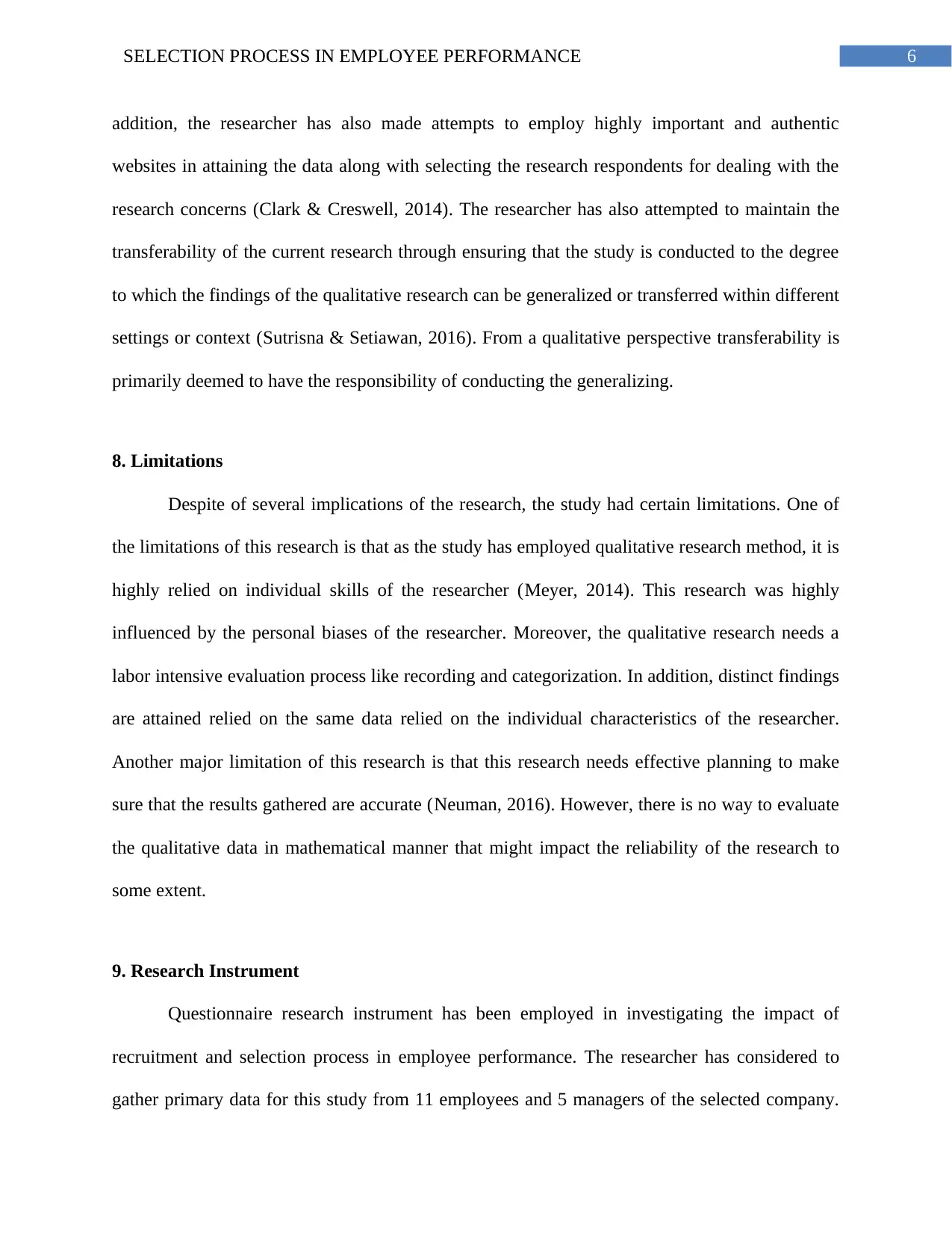
6SELECTION PROCESS IN EMPLOYEE PERFORMANCE
addition, the researcher has also made attempts to employ highly important and authentic
websites in attaining the data along with selecting the research respondents for dealing with the
research concerns (Clark & Creswell, 2014). The researcher has also attempted to maintain the
transferability of the current research through ensuring that the study is conducted to the degree
to which the findings of the qualitative research can be generalized or transferred within different
settings or context (Sutrisna & Setiawan, 2016). From a qualitative perspective transferability is
primarily deemed to have the responsibility of conducting the generalizing.
8. Limitations
Despite of several implications of the research, the study had certain limitations. One of
the limitations of this research is that as the study has employed qualitative research method, it is
highly relied on individual skills of the researcher (Meyer, 2014). This research was highly
influenced by the personal biases of the researcher. Moreover, the qualitative research needs a
labor intensive evaluation process like recording and categorization. In addition, distinct findings
are attained relied on the same data relied on the individual characteristics of the researcher.
Another major limitation of this research is that this research needs effective planning to make
sure that the results gathered are accurate (Neuman, 2016). However, there is no way to evaluate
the qualitative data in mathematical manner that might impact the reliability of the research to
some extent.
9. Research Instrument
Questionnaire research instrument has been employed in investigating the impact of
recruitment and selection process in employee performance. The researcher has considered to
gather primary data for this study from 11 employees and 5 managers of the selected company.
addition, the researcher has also made attempts to employ highly important and authentic
websites in attaining the data along with selecting the research respondents for dealing with the
research concerns (Clark & Creswell, 2014). The researcher has also attempted to maintain the
transferability of the current research through ensuring that the study is conducted to the degree
to which the findings of the qualitative research can be generalized or transferred within different
settings or context (Sutrisna & Setiawan, 2016). From a qualitative perspective transferability is
primarily deemed to have the responsibility of conducting the generalizing.
8. Limitations
Despite of several implications of the research, the study had certain limitations. One of
the limitations of this research is that as the study has employed qualitative research method, it is
highly relied on individual skills of the researcher (Meyer, 2014). This research was highly
influenced by the personal biases of the researcher. Moreover, the qualitative research needs a
labor intensive evaluation process like recording and categorization. In addition, distinct findings
are attained relied on the same data relied on the individual characteristics of the researcher.
Another major limitation of this research is that this research needs effective planning to make
sure that the results gathered are accurate (Neuman, 2016). However, there is no way to evaluate
the qualitative data in mathematical manner that might impact the reliability of the research to
some extent.
9. Research Instrument
Questionnaire research instrument has been employed in investigating the impact of
recruitment and selection process in employee performance. The researcher has considered to
gather primary data for this study from 11 employees and 5 managers of the selected company.
Paraphrase This Document
Need a fresh take? Get an instant paraphrase of this document with our AI Paraphraser
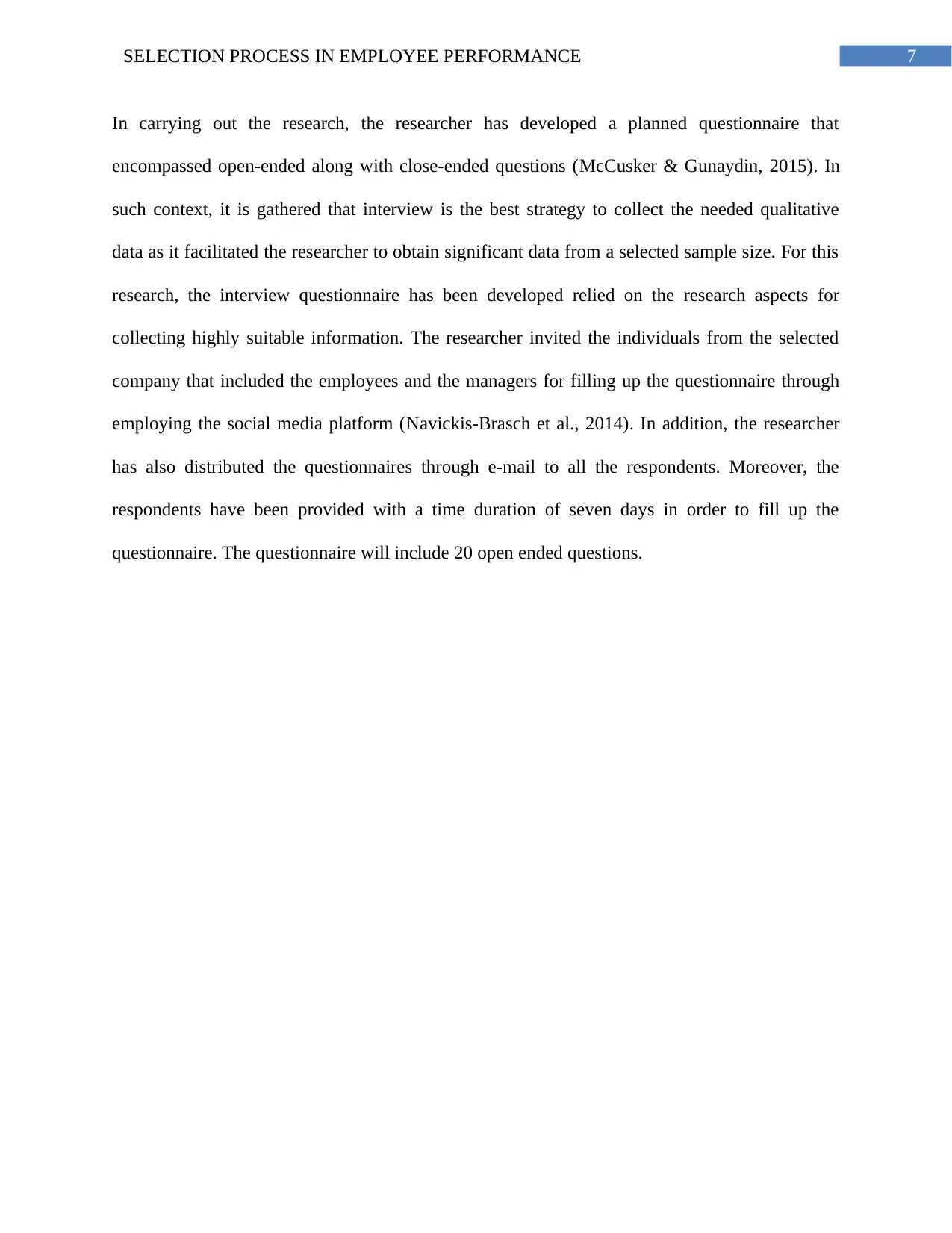
7SELECTION PROCESS IN EMPLOYEE PERFORMANCE
In carrying out the research, the researcher has developed a planned questionnaire that
encompassed open-ended along with close-ended questions (McCusker & Gunaydin, 2015). In
such context, it is gathered that interview is the best strategy to collect the needed qualitative
data as it facilitated the researcher to obtain significant data from a selected sample size. For this
research, the interview questionnaire has been developed relied on the research aspects for
collecting highly suitable information. The researcher invited the individuals from the selected
company that included the employees and the managers for filling up the questionnaire through
employing the social media platform (Navickis-Brasch et al., 2014). In addition, the researcher
has also distributed the questionnaires through e-mail to all the respondents. Moreover, the
respondents have been provided with a time duration of seven days in order to fill up the
questionnaire. The questionnaire will include 20 open ended questions.
In carrying out the research, the researcher has developed a planned questionnaire that
encompassed open-ended along with close-ended questions (McCusker & Gunaydin, 2015). In
such context, it is gathered that interview is the best strategy to collect the needed qualitative
data as it facilitated the researcher to obtain significant data from a selected sample size. For this
research, the interview questionnaire has been developed relied on the research aspects for
collecting highly suitable information. The researcher invited the individuals from the selected
company that included the employees and the managers for filling up the questionnaire through
employing the social media platform (Navickis-Brasch et al., 2014). In addition, the researcher
has also distributed the questionnaires through e-mail to all the respondents. Moreover, the
respondents have been provided with a time duration of seven days in order to fill up the
questionnaire. The questionnaire will include 20 open ended questions.
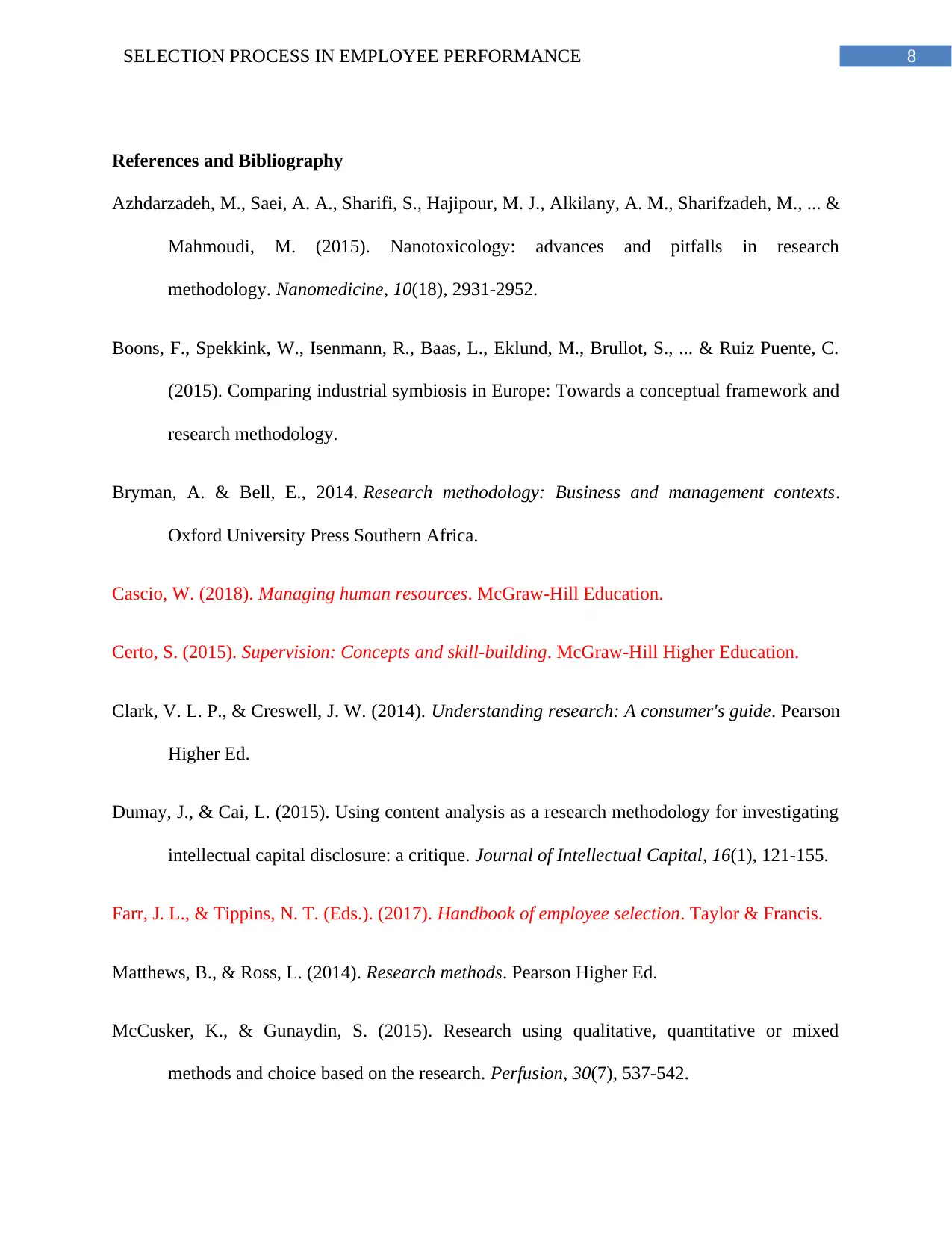
8SELECTION PROCESS IN EMPLOYEE PERFORMANCE
References and Bibliography
Azhdarzadeh, M., Saei, A. A., Sharifi, S., Hajipour, M. J., Alkilany, A. M., Sharifzadeh, M., ... &
Mahmoudi, M. (2015). Nanotoxicology: advances and pitfalls in research
methodology. Nanomedicine, 10(18), 2931-2952.
Boons, F., Spekkink, W., Isenmann, R., Baas, L., Eklund, M., Brullot, S., ... & Ruiz Puente, C.
(2015). Comparing industrial symbiosis in Europe: Towards a conceptual framework and
research methodology.
Bryman, A. & Bell, E., 2014. Research methodology: Business and management contexts.
Oxford University Press Southern Africa.
Cascio, W. (2018). Managing human resources. McGraw-Hill Education.
Certo, S. (2015). Supervision: Concepts and skill-building. McGraw-Hill Higher Education.
Clark, V. L. P., & Creswell, J. W. (2014). Understanding research: A consumer's guide. Pearson
Higher Ed.
Dumay, J., & Cai, L. (2015). Using content analysis as a research methodology for investigating
intellectual capital disclosure: a critique. Journal of Intellectual Capital, 16(1), 121-155.
Farr, J. L., & Tippins, N. T. (Eds.). (2017). Handbook of employee selection. Taylor & Francis.
Matthews, B., & Ross, L. (2014). Research methods. Pearson Higher Ed.
McCusker, K., & Gunaydin, S. (2015). Research using qualitative, quantitative or mixed
methods and choice based on the research. Perfusion, 30(7), 537-542.
References and Bibliography
Azhdarzadeh, M., Saei, A. A., Sharifi, S., Hajipour, M. J., Alkilany, A. M., Sharifzadeh, M., ... &
Mahmoudi, M. (2015). Nanotoxicology: advances and pitfalls in research
methodology. Nanomedicine, 10(18), 2931-2952.
Boons, F., Spekkink, W., Isenmann, R., Baas, L., Eklund, M., Brullot, S., ... & Ruiz Puente, C.
(2015). Comparing industrial symbiosis in Europe: Towards a conceptual framework and
research methodology.
Bryman, A. & Bell, E., 2014. Research methodology: Business and management contexts.
Oxford University Press Southern Africa.
Cascio, W. (2018). Managing human resources. McGraw-Hill Education.
Certo, S. (2015). Supervision: Concepts and skill-building. McGraw-Hill Higher Education.
Clark, V. L. P., & Creswell, J. W. (2014). Understanding research: A consumer's guide. Pearson
Higher Ed.
Dumay, J., & Cai, L. (2015). Using content analysis as a research methodology for investigating
intellectual capital disclosure: a critique. Journal of Intellectual Capital, 16(1), 121-155.
Farr, J. L., & Tippins, N. T. (Eds.). (2017). Handbook of employee selection. Taylor & Francis.
Matthews, B., & Ross, L. (2014). Research methods. Pearson Higher Ed.
McCusker, K., & Gunaydin, S. (2015). Research using qualitative, quantitative or mixed
methods and choice based on the research. Perfusion, 30(7), 537-542.
⊘ This is a preview!⊘
Do you want full access?
Subscribe today to unlock all pages.

Trusted by 1+ million students worldwide

9SELECTION PROCESS IN EMPLOYEE PERFORMANCE
Naff, K. C., Riccucci, N. M., & Freyss, S. F. (2017). Personnel management in government:
Politics and process. Routledge.
Naff, K. C., Riccucci, N. M., & Freyss, S. F. (2017). Personnel management in government:
Politics and process. Routledge.
Paraphrase This Document
Need a fresh take? Get an instant paraphrase of this document with our AI Paraphraser
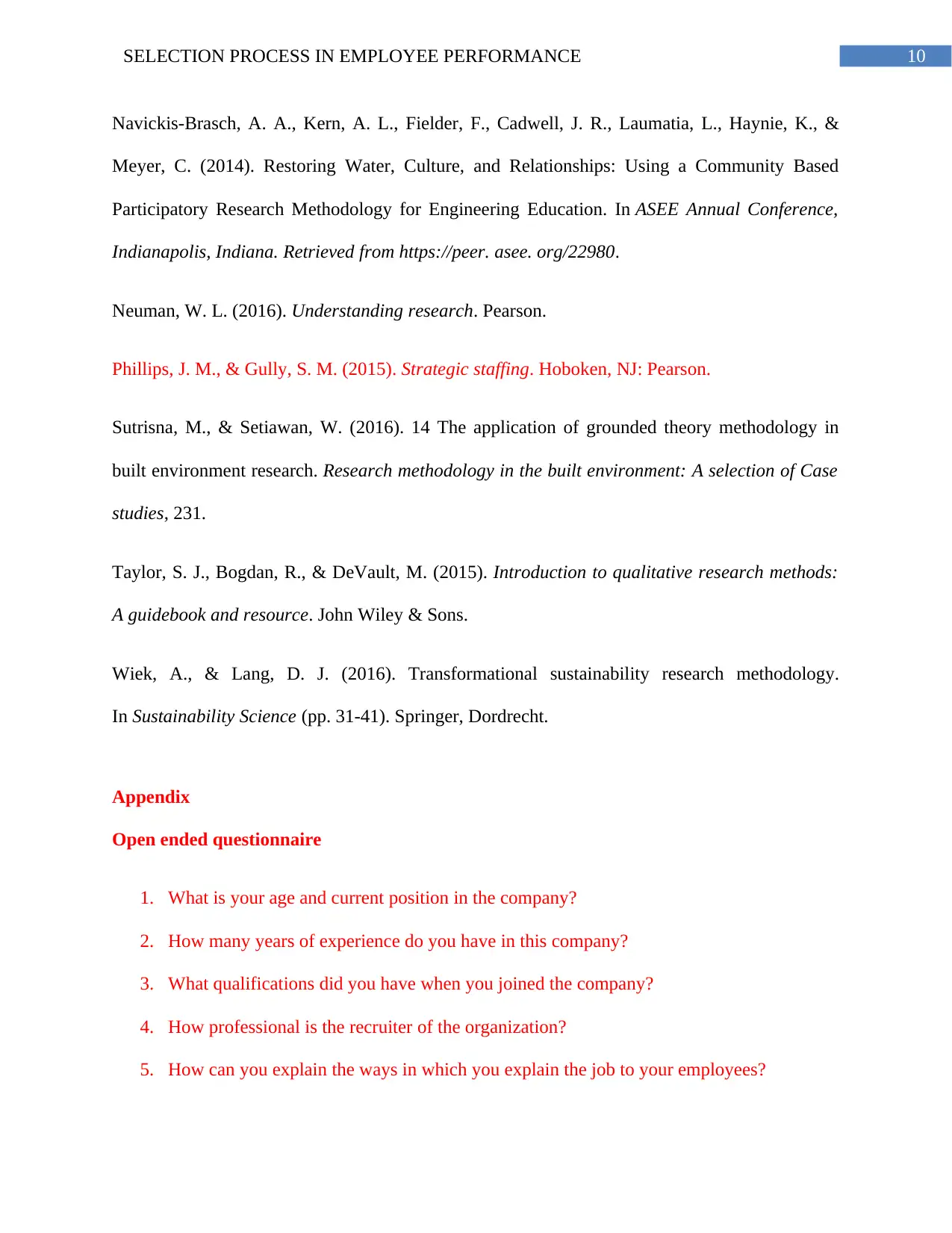
10SELECTION PROCESS IN EMPLOYEE PERFORMANCE
Navickis-Brasch, A. A., Kern, A. L., Fielder, F., Cadwell, J. R., Laumatia, L., Haynie, K., &
Meyer, C. (2014). Restoring Water, Culture, and Relationships: Using a Community Based
Participatory Research Methodology for Engineering Education. In ASEE Annual Conference,
Indianapolis, Indiana. Retrieved from https://peer. asee. org/22980.
Neuman, W. L. (2016). Understanding research. Pearson.
Phillips, J. M., & Gully, S. M. (2015). Strategic staffing. Hoboken, NJ: Pearson.
Sutrisna, M., & Setiawan, W. (2016). 14 The application of grounded theory methodology in
built environment research. Research methodology in the built environment: A selection of Case
studies, 231.
Taylor, S. J., Bogdan, R., & DeVault, M. (2015). Introduction to qualitative research methods:
A guidebook and resource. John Wiley & Sons.
Wiek, A., & Lang, D. J. (2016). Transformational sustainability research methodology.
In Sustainability Science (pp. 31-41). Springer, Dordrecht.
Appendix
Open ended questionnaire
1. What is your age and current position in the company?
2. How many years of experience do you have in this company?
3. What qualifications did you have when you joined the company?
4. How professional is the recruiter of the organization?
5. How can you explain the ways in which you explain the job to your employees?
Navickis-Brasch, A. A., Kern, A. L., Fielder, F., Cadwell, J. R., Laumatia, L., Haynie, K., &
Meyer, C. (2014). Restoring Water, Culture, and Relationships: Using a Community Based
Participatory Research Methodology for Engineering Education. In ASEE Annual Conference,
Indianapolis, Indiana. Retrieved from https://peer. asee. org/22980.
Neuman, W. L. (2016). Understanding research. Pearson.
Phillips, J. M., & Gully, S. M. (2015). Strategic staffing. Hoboken, NJ: Pearson.
Sutrisna, M., & Setiawan, W. (2016). 14 The application of grounded theory methodology in
built environment research. Research methodology in the built environment: A selection of Case
studies, 231.
Taylor, S. J., Bogdan, R., & DeVault, M. (2015). Introduction to qualitative research methods:
A guidebook and resource. John Wiley & Sons.
Wiek, A., & Lang, D. J. (2016). Transformational sustainability research methodology.
In Sustainability Science (pp. 31-41). Springer, Dordrecht.
Appendix
Open ended questionnaire
1. What is your age and current position in the company?
2. How many years of experience do you have in this company?
3. What qualifications did you have when you joined the company?
4. How professional is the recruiter of the organization?
5. How can you explain the ways in which you explain the job to your employees?
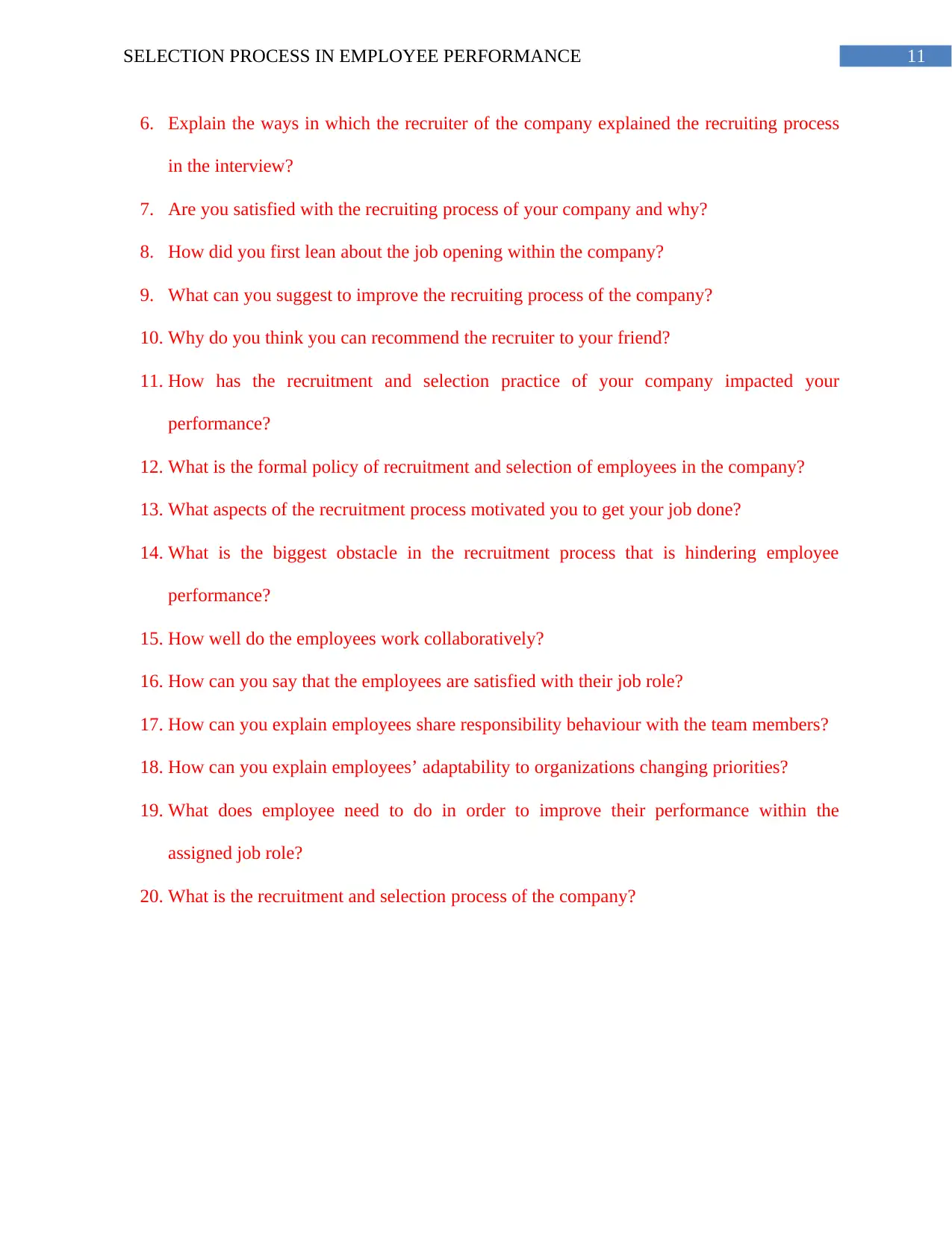
11SELECTION PROCESS IN EMPLOYEE PERFORMANCE
6. Explain the ways in which the recruiter of the company explained the recruiting process
in the interview?
7. Are you satisfied with the recruiting process of your company and why?
8. How did you first lean about the job opening within the company?
9. What can you suggest to improve the recruiting process of the company?
10. Why do you think you can recommend the recruiter to your friend?
11. How has the recruitment and selection practice of your company impacted your
performance?
12. What is the formal policy of recruitment and selection of employees in the company?
13. What aspects of the recruitment process motivated you to get your job done?
14. What is the biggest obstacle in the recruitment process that is hindering employee
performance?
15. How well do the employees work collaboratively?
16. How can you say that the employees are satisfied with their job role?
17. How can you explain employees share responsibility behaviour with the team members?
18. How can you explain employees’ adaptability to organizations changing priorities?
19. What does employee need to do in order to improve their performance within the
assigned job role?
20. What is the recruitment and selection process of the company?
6. Explain the ways in which the recruiter of the company explained the recruiting process
in the interview?
7. Are you satisfied with the recruiting process of your company and why?
8. How did you first lean about the job opening within the company?
9. What can you suggest to improve the recruiting process of the company?
10. Why do you think you can recommend the recruiter to your friend?
11. How has the recruitment and selection practice of your company impacted your
performance?
12. What is the formal policy of recruitment and selection of employees in the company?
13. What aspects of the recruitment process motivated you to get your job done?
14. What is the biggest obstacle in the recruitment process that is hindering employee
performance?
15. How well do the employees work collaboratively?
16. How can you say that the employees are satisfied with their job role?
17. How can you explain employees share responsibility behaviour with the team members?
18. How can you explain employees’ adaptability to organizations changing priorities?
19. What does employee need to do in order to improve their performance within the
assigned job role?
20. What is the recruitment and selection process of the company?
⊘ This is a preview!⊘
Do you want full access?
Subscribe today to unlock all pages.

Trusted by 1+ million students worldwide
1 out of 12
Related Documents
Your All-in-One AI-Powered Toolkit for Academic Success.
+13062052269
info@desklib.com
Available 24*7 on WhatsApp / Email
![[object Object]](/_next/static/media/star-bottom.7253800d.svg)
Unlock your academic potential
Copyright © 2020–2025 A2Z Services. All Rights Reserved. Developed and managed by ZUCOL.





